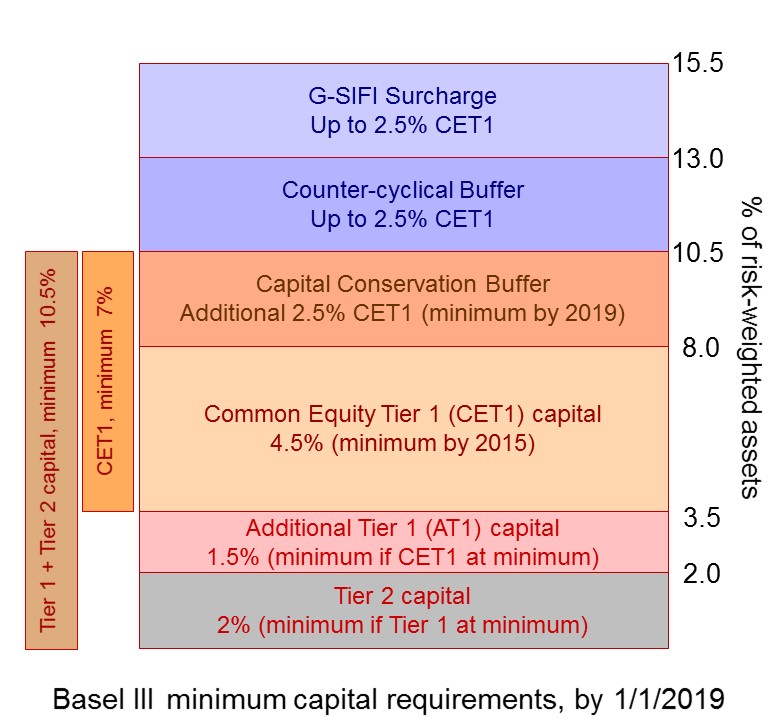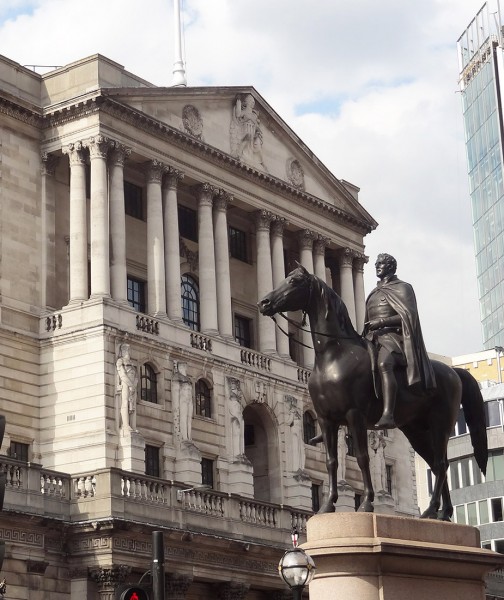 Under the auspices of the Bank for International Settlements (BIS), banks around the world are working their way towards implementing tougher capital requirements. These tougher rules, known as ‘Basel III’, are due to come fully into operation by 2019.
Under the auspices of the Bank for International Settlements (BIS), banks around the world are working their way towards implementing tougher capital requirements. These tougher rules, known as ‘Basel III’, are due to come fully into operation by 2019.
This third version of international banking rules was agreed after the financial crisis of 2008, when many banks were so undercapitalised that they could not withstand the dramatic decline in the value of many of their assets and a withdrawal of funds.
Basel III requires banks to have much more capital, especially common equity capital. The point about equity (shares) is that it’s a liability that does not have to be repaid. If people hold bank shares, the bank does not have to repay them and does not even have to pay any dividends. In other words, the money raised by issuing shares carries no obligation on the part of the bank and can thus provide a buffer against large-scale withdrawal of funds.
Under Basel III, banks have to maintain sufficiently large ‘capital-adequacy ratios’. As Essentials of Economics (7th edition) explains:
Capital adequacy is a measure of a bank’s capital relative to its assets, where the assets are weighted according to the degree of risk. The more risky the assets, the greater the amount of capital that will be required.
A measure of capital adequacy is given by the capital adequacy ratio (CAR). This is given by the following formula:

Common Equity Tier 1 (CET1) capital includes bank reserves (from retained profits) and ordinary share capital (equities), where dividends to shareholders vary with the amount of profit the bank makes… Additional Tier 1 (AT1) capital consists largely of preference shares. These pay a fixed dividend (like company bonds), but although preference shareholders have a prior claim over ordinary shareholders on the company’s (i.e. the bank’s) profits, dividends need not be paid in times of loss.
 Tier 2 capital is subordinated debt with a maturity greater than 5 years. Subordinated debt holders only have a claim on a company (a bank) after the claims of all other bondholders have been met.
Tier 2 capital is subordinated debt with a maturity greater than 5 years. Subordinated debt holders only have a claim on a company (a bank) after the claims of all other bondholders have been met.
Risk-weighted assets are the total value of assets, where each type of asset is multiplied by a risk factor. Under the Basel III accord, cash and government bonds have a risk factor of zero and are thus not included. Interbank lending between the major banks has a risk factor of 0.2 and is thus included at only 20 per cent of its value; residential mortgages under 60% of the value of the property have a risk factor of 0.35; personal loans, credit-card debt and overdrafts have a risk factor of 1; loans to companies carry a risk factor of 0.2, 0.5, 1 or 1.5, depending on the credit rating of the company. Thus the greater the average risk factor of a bank’s assets, the greater will be the value of its risk weighted assets, and the lower will be its CAR.
 Basel III gives minimum capital requirements that are higher than under its predecessor, Basel II. Thus, by 2019, banks must have a common equity capital to risk-weighted assets of at least 4.5% and a Tier 1 ratio of at least 6.0%. The overall CAR should be at least 8%. In addition, the phased introduction of a ‘capital conservation buffer’ from 2016 will raise the overall CAR to at least 10.5 per cent.
Basel III gives minimum capital requirements that are higher than under its predecessor, Basel II. Thus, by 2019, banks must have a common equity capital to risk-weighted assets of at least 4.5% and a Tier 1 ratio of at least 6.0%. The overall CAR should be at least 8%. In addition, the phased introduction of a ‘capital conservation buffer’ from 2016 will raise the overall CAR to at least 10.5 per cent.
Over the past few years, banks have increased their capital cushions significantly and many have exceeded the Basel III requirements, even for 2019.
But the Basel Committee has been reconsidering the calculation of risk-weighted assets. Because of the complexity of banks’ asset structures, which tend to vary significantly from country to country, it is difficult to ensure that banks’ are meeting the Basel III requirements. Under proposed amendments to Basel III (which some commentators have dubbed ‘Basel IV’), banks would have to compare their own calculations with a ‘standardised’ model. Their own calculations of risk-based assets would then not be allowed to be lower than 60–90% (known as ‘the output floor’) of the standardised approach.
While, on the surface, this may seem reasonable, European banks have claimed that this would penalise them, as some of their assets are less risky than the equivalent assets in other countries. For example, Germany has argued that mortgage defaults have been rare and thus German mortgage debt should be given a lower weighting than US mortgage debt, where defaults have been more common. If all assets were assessed according to the output floor, several banks, especially in Europe, would be judged to be undercapitalised. As The Economist article states:
Analysts at Morgan Stanley estimate that global, non-American banks could see risk-weighted assets rise by an average of 18–30%, depending on the level of the output floor. Extra capital of €250bn–410bn could be needed, a tall order when earnings are thin and investors wary. The committee’s reviews of operational and market risks would add even more.
This question of an output floor was a sticking point at the Basel Committee meeting in Santiago, which ended on 30 November. Although some progress was made about agreeing to rules on risk weighting that could be applied globally, a final agreement will have to wait until the next meeting, in January – at the earliest.
Articles
Basel bust-up: A showdown looms over bank-capital rules The Economist (26/11/16)
Bank regulators fail to agree on new rules Manila Standard (2/12/16)
Bank chief Claudio Borio urges regulators to ‘stay strong’ Weekend Australian, Michael Bennet (29/11/16)
Final Basel III rules meet resistance from Europe The Straits Times (2/12/16)
This Is the Absolutely Worst Time to Weaken Global Bank Rules American Banker, Mayra Rodriguez Valladares (2/12/16)
New Basel banking rules’ impact on European economy Financial Times, Frédéric Oudéa (28/12/16)
Banks like RBS still look risky, but getting too tough could cause greater problems The Conversation, Alan Shipman (1/12/16)
BIS publications
International banking supervisory community meets to discuss the regulatory framework BIS Press Release (1/12/16)
Basel III: international regulatory framework for banks Bank for International Settlements
Basel III phase-in arrangements Basel Committee on Banking Supervision, BIS
Basel Committee on Banking Supervision reforms – Basel III, Summary Table Basel Committee on Banking Supervision, BIS
Questions
- Why do reserves in banks have a zero weighting in terms of risk-based assets?
- What items have a 100% weighting? Explain why.
- Examine the table, Basel III phase-in arrangements, and explain each of the terms.
- If banks are forced to operate with a higher capital adequacy ratio, what is this likely to do to bank lending? Explain. How are funding costs relevant to your answer?
- Explain each of the items in the Basel III capital-adequacy requirements shown in the chart above.
- What is the American case for imposing an output floor?
- What is the European banks’ case for using their own risk weighting?
- Why is it proposed that larger ‘systemically important banks’ (SIBs) should have an additional capital requirement?
- How does the balance of assets of American banks differ from that of European banks?
 In a recent post, Global Warning, we looked at concerns about the global economy. One of these was about the ineffectiveness of monetary policy to stimulate aggregate demand and to restore growth rates. Despite the use of unconventional monetary policies, such as quantitative easing and negative interest rates, and despite the fact that these policies have become the new convention, they have failed to do enough to bring sustained recovery.
In a recent post, Global Warning, we looked at concerns about the global economy. One of these was about the ineffectiveness of monetary policy to stimulate aggregate demand and to restore growth rates. Despite the use of unconventional monetary policies, such as quantitative easing and negative interest rates, and despite the fact that these policies have become the new convention, they have failed to do enough to bring sustained recovery.
The two articles below argue that the failure has been due to a flawed model of monetary policy: one that takes too little account of the behaviour of banks and the drivers of consumption and of physical investment. Negative interest rates on banks’ holdings of reserves in central banks are hardly likely to push down lending rates to businesses sufficiently to stimulate investment in new plant and machinery if firms already have overcapacity. And consumers are unlikely to borrow more for consumption if their wages are barely rising and they already have debts that they fear will be difficulty to pay off.
As Joseph Stiglitz points out:
As real interest rates have fallen, business investment has stagnated. According to the OECD, the percentage of GDP invested in a category that is mostly plant and equipment has fallen in both Europe and the US in recent years. (In the US, it fell from 8.4% in 2000 to 6.8% in 2014; in the EU, it fell from 7.5% to 5.7% over the same period.) Other data provide a similar picture.
And the unwillingness of many firms and individuals to borrow is matched by banks’ caution about lending in an uncertain economic environment. Many are more concerned about building their capital and liquidity ratios to protect themselves. In these circumstances, negative interest rates have little effect on stimulating bank lending and, by hurting their balance sheets through lower earnings on the money markets, may even encourage them to lend less
In these circumstances, negative interest rates have little effect on stimulating bank lending and, by hurting their balance sheets through lower earnings on the money markets, may even encourage them to lend less
What central banks should be doing, argue both Stiglitz and Elliott, is finding ways of directly stimulating consumption and investment. Perhaps this will involve central banks “focusing on the flow of credit, which means restoring and maintaining local banks’ ability and willingness to lend to SMEs.” Perhaps it will mean using helicopter money, as we examined in the previous blog. As Larry Elliott points out:
The fact that economists at Deutsche Bank published a helpful cut-out-and-keep guide to helicopter  money last week is a straw in the wind.
money last week is a straw in the wind.
As the Deutsche research makes clear, the most basic variant of helicopter money involves a central bank creating money so that it can be handed to the finance ministry to spend on tax cuts or higher public spending. There are two differences with QE. The cash goes directly to firms and individuals rather than being channelled through banks, and there is no intention of the central bank ever getting it back.
So if the model of monetary policy is indeed flawed, prepare for more unconventional measures
Articles
What’s Wrong With Negative Rates?, Project Syndicate, Joseph Stiglitz (13/4/16)
The bad smell hovering over the global economy The Guardian, Larry Elliott (17/4/16)
Questions
- What arguments does Stiglitz use to support his claim that the model of monetary policy currently being used is flawed?
- In what ways has monetary policy hurt older people and what has been the effect on their spending and on aggregate demand in general?
- Why has monetary policy encouraged investors to shift their portfolios toward riskier assets?
- Examine the argument that ultra-low interest rates may result in a rise in unemployment in the long term by affecting the relative prices of capital and labour.
- What forms might helicopter money take?
- Would the use of helicopter money necessarily result in an increase in aggregate demand? What would determine the size of any such increase?
 As part of the Basel III round of banking regulations, representatives of the EU Parliament and member governments have agreed with the European Commission that bankers’ bonuses should be capped. The proposal is to cap them at 100% of annual salary, or 200% with the agreement of shareholders. The full Parliament will vote in May and then it will go to officials from the 27 Member States. Under a system of qualified majority voting, it is expected to be accepted, despite UK resistance.
As part of the Basel III round of banking regulations, representatives of the EU Parliament and member governments have agreed with the European Commission that bankers’ bonuses should be capped. The proposal is to cap them at 100% of annual salary, or 200% with the agreement of shareholders. The full Parliament will vote in May and then it will go to officials from the 27 Member States. Under a system of qualified majority voting, it is expected to be accepted, despite UK resistance.
The main arguments in favour of a cap are that it will reduce the focus of bankers on short-term gains and reduce the incentive to take excessive risks. It will also appease the anger of electorates throughout the EU over bankers getting huge bonuses, especially in the light of the recession, caused in major part by the excesses of bankers.
 The main argument against is that it will drive talented top bankers to countries outside the EU. This is a particular worry of the UK government, fearful of the effect on the City of London. There is also the criticism that it will simply drive banks into increasing basic salaries of senior executives to compensate for lower bonuses.
The main argument against is that it will drive talented top bankers to countries outside the EU. This is a particular worry of the UK government, fearful of the effect on the City of London. There is also the criticism that it will simply drive banks into increasing basic salaries of senior executives to compensate for lower bonuses.
But it is not just the EU considering curbing bankers’ pay. The Swiss have just voted in a referendum to give shareholders the right to veto salaries and bonuses of executives of major companies. Many of these companies are banks or other financial sector organisations.
So just what will be the effect on incentives, banks’ performance and the movement of top bankers to countries without such caps? The following videos and articles explore these issues. As you will see, the topic is highly controversial and politically charged.
 Meanwhile, HSBC has revealed its 2012 results. It paid out $1.9bn in fines for money laundering and set aside a further $2.3bn for mis-selling financial products in the UK. But its underlying profits were up 18%. Bonuses were up too. The 16 top executives received an average of $4.9m each. The Chief Executive, Stuart Gulliver, received $14.1m in 2012, 33% up on 2011 (see final article below).
Meanwhile, HSBC has revealed its 2012 results. It paid out $1.9bn in fines for money laundering and set aside a further $2.3bn for mis-selling financial products in the UK. But its underlying profits were up 18%. Bonuses were up too. The 16 top executives received an average of $4.9m each. The Chief Executive, Stuart Gulliver, received $14.1m in 2012, 33% up on 2011 (see final article below).
Webcasts and podcasts
 EU moves to cap bankers bonuses Euronews on Yahoo News (1/3/13)
EU moves to cap bankers bonuses Euronews on Yahoo News (1/3/13)
 EU to Curb Bank Bonuses WSJ Live (28/2/13)
EU to Curb Bank Bonuses WSJ Live (28/2/13)
 Inside Story – Curbing Europe’s bank bonuses AlJazeera on YouTube (1/3/13)
Inside Story – Curbing Europe’s bank bonuses AlJazeera on YouTube (1/3/13)
 Will EU bonus cap ‘damage economy’? BBC Radio 4 Today Programme (28/2/13)
Will EU bonus cap ‘damage economy’? BBC Radio 4 Today Programme (28/2/13)
 Swiss back curbs on executive pay in referendum BBC News (3/3/13)
Swiss back curbs on executive pay in referendum BBC News (3/3/13)
 Has the HSBC scandal impacted on business? BBC News, Jeremy Howell (4/3/13)
Has the HSBC scandal impacted on business? BBC News, Jeremy Howell (4/3/13)
Articles
Bonuses: the essential guide The Guardian, Simon Bowers, Jill Treanor, Fiona Walsh, Julia Finch, Patrick Collinson and Ian Traynor (28/2/13)
Q&A: EU banker bonus cap plan BBC News (28/2/13)
Outcry, and a Little Cunning, From Euro Bankers The New York Times, Landon Thomas Jr. (28/2/13)
Bank bonuses may shrink – but watch as the salaries rise The Observer, Rob Taylor (3/3/13)
Don’t cap bank bonuses, scrap them The Guardian, Deborah Hargreaves (28/2/13)
Capping banker bonuses simply avoids facing real bank problems The Telegraph, Mats Persson (2/3/13)
Pro bonus The Economist, Schumpeter column (28/2/13)
‘The most deluded measure to come from Europe since fixing the price of groceries in the Roman Empire’: Boris Johnson attacks EU banker bonus cap Independent, Gavin Cordon , Geoff Meade (28/2/13)
EU agrees to cap bankers’ bonuses BBC News (28/2/13)
Viewpoints: EU banker bonus cap BBC News (28/2/13)
Voters crack down on corporate pay packages swissinfo.ch , Urs Geiser (3/3/13)
Swiss voters seen backing executive pay curbs Reuters, Emma Thomasson (3/3/13)
Swiss referendum backs executive pay curbs BBC News (3/3/13)
Voters in Swiss referendum back curbs on executives’ pay and bonuses The Guardian, Kim Willsher and Phillip Inman (3/3/13)
Swiss vote for corporate pay curbs Financial Times, James Shotter and Alex Barker (3/3/13)
HSBC pays $4.2bn for fines and mis-selling in 2012 BBC News (4/3/13)
Questions
- How does competition, or a lack of it, in the banking industry affect senior bankers’ remuneration?
- What incentives are created by the bonus structure as it is now? Do these incentives result in desirable outcomes?
- How would you redesign the bonus system so that the incentives resulted in beneficial outcomes?
- If bonuses are capped as proposed by the EU, how would you assess the balance of advantages and disadvantages? What additional information would you need to know to make such an assessment?
- How has the relationship between banks and central banks over the past few years created a moral hazard? How could such a moral hazard be eliminated?
At its meeting on 26 October, the eurozone countries agreed on a deal to tackle the three problems identified in Part A of this blog:
1. Making the Greek debt burden sustainable
2. Increasing the size of the eurozone bailout fund to persuade markets that there would be sufficient funding to support other eurozone countries which were having difficulties in servicing their debt.
3. Recapitalising various European banks to shield them against possible losses from haircuts and defaults.
The following were agreed:
1. Banks would be required to take a loss of 50% in converting existing Greek bonds into new ones. This swap will take place in January 2012. Note that Greek debt to other countries and the ECB would be unaffected and thus total Greek debt would be cut by considerably less than 50%.
2. The bailout fund (EFSF) would increase to between €1 trillion and €1.4 trillion, although this would be achieved not by direct contributions by Member States or the ECB, but by encouraging non-eurozone countries (such as China, Russia, India and Brazil) to buy eurozone debt in return for risk insurance. These purchases would the form the base on which the size of the fund could be multiplied (leveraged). There would also be backing from the IMF. Details would be firmed up in November.
3. Recapitalising various European banks to shield them against possible losses from haircuts and defaults. About 70 banks will be required to raise an additional €106.4 billion by increasing their Tier 1 capital ratio by 9% by June 2012 (this compares with the Basel III requirement of 6% Tier 1 by 2015).
On the longer-term issue of closer fiscal union, the agreement was in favour of achieving this, along with tight constraints on the levels of government deficits and debt – a return to something akin to the Stability and Growth Pact.
On the issue of economic growth, whilst constraining sovereign debt may be an important element of a long-term growth strategy, the agreement has not got to grips with the short-term problem of a lack of aggregate demand – unless, of course, the relief in markets at seeing a solution to the debt problem may boost business and consumer confidence. This, in turn, may provide the boost to aggregate demand that has been sadly lacking over the past few months.
Certainly if the reaction of stock markets around the world are anything to go by, the recovery in confidence may be under way. The day following the agreement, the German stock market index, the Dax, rose by 6.3% and the French Cac index rose by 5.4%.
Articles
Eurozone crisis explained BBC News (27/10/11)
 Leaders agree eurozone debt plan in Brussels BBC News, Matthew Price (27/10/11)
Leaders agree eurozone debt plan in Brussels BBC News, Matthew Price (27/10/11)
 Eurozone agreement – the detail BBC News, Hugh Pym (27/10/11)
Eurozone agreement – the detail BBC News, Hugh Pym (27/10/11)
10 key questions on the eurozone bailout Citywire Money, Caelainn Barr (27/10/11)
 European debt crisis: ‘Europe is going to have a very tough winter’ – video analysis Guardian, Larry Elliott (27/10/11)
European debt crisis: ‘Europe is going to have a very tough winter’ – video analysis Guardian, Larry Elliott (27/10/11)
 Eurozone crisis: banks agree 50% reduction on Greece’s debt Guardian, David Gow (27/10/11)
Eurozone crisis: banks agree 50% reduction on Greece’s debt Guardian, David Gow (27/10/11)
The euro deal: No big bazooka The Economist (29/10/11)
Europe’s rescue plan The Economist (29/10/11)
European banks given just eight months to raise €106bn The Telegraph, Louise Armitstead (26/10/11)
EU reaches agreement on Greek bonds Financial Times, Peter Spiegel, Stanley Pignal and Alex Barker (27/10/11)
Unlike politicians, the markets are seeing sense Independent, Hamish McRae (27/10/11)
Market view: Eurozone rescue deal buys time FT Adviser, Michael Trudeau (27/10/11)
Greece vows to build on EU deal, people sceptical Reuters, Renee Maltezou and Daniel Flynn (27/10/11)
Markets boosted by eurozone deal Independent, Peter Cripps, Jamie Grierson (27/10/11)
Has Germany been prudent or short-sighted? BBC News blogs, Robert Peston (27/10/11)
 Germany’s Fiscal union with a capital F BBC News blogs, Stephanie Flanders (27/10/11)
Germany’s Fiscal union with a capital F BBC News blogs, Stephanie Flanders (27/10/11)
Questions
- What are the key features of the deal reached in Brussels on 26 October?
- What details still need to be worked out?
- How will the EFSF be boosted some 4 or 5 times without extra contributions fron eurozone governments?
- Why, if banks are to take a 50% haircut on their holdings of Greek debt, will Greek debt fall only to 120% per cent by 2020 from just over 160% currently?
- On balance, is this a good deal?
As European leaders gather for an emergency summit in Brussels to tackle the eurozone debt crisis, we consider the issues and possible solutions. In Part B we’ll consider the actual agreement.
There are three key short-term issues that the leaders are addressing.
1. The problem of Greek debt
With fears that the Greek debt crisis could spread to other eurozone countries, such as Italy and Spain, it is vital to have a solution to the unsustainability of Greek debt. Either banks must be willing to write off a proportion of Greek debt owed to them or governments must give a fiscal transfer to Greece to allow it to continue servicing the debt. Simply lending Greece even more provides no long-term solution as this will simply make the debt even harder to service. Writing off a given percentage of debt is known as a ‘haircut’. The haircut on offer before the summit was 21%. Leaders are reportedly considering increasing this to around 60%.
2. The size of the eurozone bailout fund
The bailout fund, the European Financial Stability Facility (EFSF), stood at €440 billion. This is considered totally inadequate to provide loans to Italy and Spain, should they need a bailout. France and other countries want the ECB to provide extra loans to the EFSF, to increase its funds to somewhere between €2 trillion and €3 trillion. Germany before the meeting was strongly against this, seeing it as undermining the rectitude of the ECB. A compromise would be for the EFSF to provide partial guarantees to investors and banks which are willing to lend more to countries in debt crisis.
3. Recapitalising various European banks
Several European banks are heavily exposed to sovereign debt in countries such as Greece, Italy and Spain. It is estimated that they would need to raise an extra €100 billion to shield them against possible losses from haircuts and defaults.
But there is the key longer-term issue as well.
Achieving long-term economic growth
Without economic growth, debt servicing becomes much more difficult. The austerity measures imposed on highly indebted countries amount to strongly contractionary fiscal policies, as government expenditure is cut and taxes are increased. But as the economies contract, so automatic fiscal stabilisers come into play. As incomes and expenditure decline, so people pay less income tax and less VAT and other expenditure taxes; as incomes decline and unemployment rises, so government welfare payments and payments of unemployment benefits increase. These compound public-sector deficits and bring the possibility of even stronger austerity measures. A downward spiral of decline and rising debt can occur.
The answer is more rapid growth. But how is that to be achieved when governments are trying to reduce debt? That is the hardest and ultimately the most important question.
Articles
Brussels summit: the main issues to be resolved The Telegraph (25/10/11)
EU crisis talks in limbo after crucial summit is cancelled The Telegraph, Louise Armitstead (25/10/11)
Euro zone summit likely to give few numbers on crisis response Reuters, Jan Strupczewski (25/10/11)
Factbox: What EU leaders must decide at crisis summit Reuters (24/10/11)
 Hopes low ahead of EU summit Euronews on YouTube (25/10/11)
Hopes low ahead of EU summit Euronews on YouTube (25/10/11)
Euro crisis: EU leaders hope to reach debt plan BBC News (26/10/11)
The deadline Europe cannot afford to miss BBC News, Nigel Cassidy (26/10/11)
 Why EU summit is crunch day for the eurozone BBC News, Paul Mason (26/10/11)
Why EU summit is crunch day for the eurozone BBC News, Paul Mason (26/10/11)
Southern European banks need most capital BBC News blogs, Robert Peston (23/10/11)
 Will Germany insure Italy against default? BBC News blogs, Robert Peston (26/10/11)
Will Germany insure Italy against default? BBC News blogs, Robert Peston (26/10/11)
Plan B for the eurozone? BBC News blogs, Stephanie Flanders (26/10/11)
 ‘No such thing as Europe’ BBC Today Programme, Stephanie Flanders and Martin Wolf (26/10/11)
‘No such thing as Europe’ BBC Today Programme, Stephanie Flanders and Martin Wolf (26/10/11)
Markets to eurozone: It’s the growth, stupid BBC News blogs, Stephanie Flanders (24/10/11)
Fears euro summit could miss final deal Financial Times, Peter Spiegel, Gerrit Wiesmann and Matt Steinglass (26/10/11)
Time to unleash financial firepower or face euro breakup Guardian, Larry Elliott (25/10/11)
 The Business podcast: eurozone crisis Guardian, Larry Elliott, David Gow and Jill Treanor (25/10/11)
The Business podcast: eurozone crisis Guardian, Larry Elliott, David Gow and Jill Treanor (25/10/11)
Why is Germany refusing to budge on the eurozone debt crisis? Guardian blogs, Phillip Inman (26/10/11)
Questions
- In terms of the three short-term problems identified above, compare alternative measures for dealing with each one.
- To what extent would the ECB creating enough money to recapitalise European banks be inflationary? On what factors does this depend?
- Does bailing out countries create a moral hazard? Explain.
- What possible ways are there of achieving economic growth while reducing countries sovereign debt?
- Would you agree that the problem facing eurozone countries at the moment is more of a political one than an economic one? Explain.
- What are the arguments for and against greater fiscal integration in the eurozone?
 Under the auspices of the Bank for International Settlements (BIS), banks around the world are working their way towards implementing tougher capital requirements. These tougher rules, known as ‘Basel III’, are due to come fully into operation by 2019.
Under the auspices of the Bank for International Settlements (BIS), banks around the world are working their way towards implementing tougher capital requirements. These tougher rules, known as ‘Basel III’, are due to come fully into operation by 2019.Tier 2 capital is subordinated debt with a maturity greater than 5 years. Subordinated debt holders only have a claim on a company (a bank) after the claims of all other bondholders have been met.
 Basel III gives minimum capital requirements that are higher than under its predecessor, Basel II. Thus, by 2019, banks must have a common equity capital to risk-weighted assets of at least 4.5% and a Tier 1 ratio of at least 6.0%. The overall CAR should be at least 8%. In addition, the phased introduction of a ‘capital conservation buffer’ from 2016 will raise the overall CAR to at least 10.5 per cent.
Basel III gives minimum capital requirements that are higher than under its predecessor, Basel II. Thus, by 2019, banks must have a common equity capital to risk-weighted assets of at least 4.5% and a Tier 1 ratio of at least 6.0%. The overall CAR should be at least 8%. In addition, the phased introduction of a ‘capital conservation buffer’ from 2016 will raise the overall CAR to at least 10.5 per cent.





